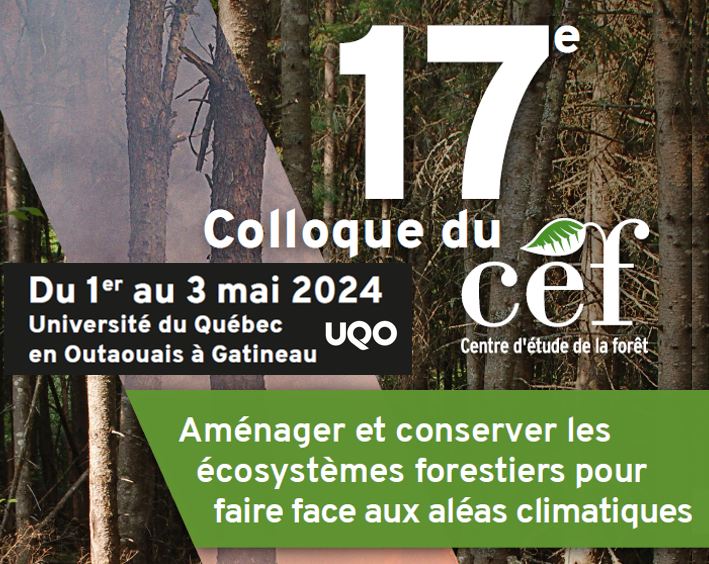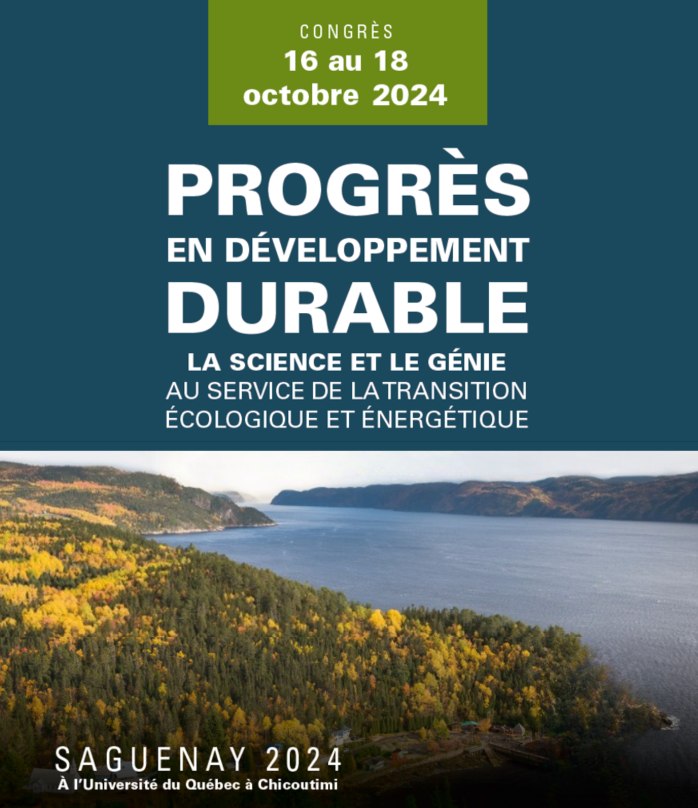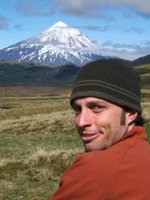
Eliot McIntire
Associate Member
Forest Ecology
Research Scientist
Canadian Forest Service
506 West Burnside Road
Victoria, British Columbia, Canada, V8Z 1M5
Adjunct Professor
University of British Columbia
Department of Forest Resources Management
Adjunct Professor
Université Laval
Département des sciences du bois et de la forêt
Pavillon Abitibi-Price, room 2115
2405 rue de la Terrasse
Québec (QC) Canada, G1V 0A6
SpaDES - R package for Ecological Forecasting ![]()
Canadian Forest Service Page ![]() | ResearcherID
| ResearcherID ![]() | ResearchGate
| ResearchGate ![]() | Google Scholar
| Google Scholar ![]() | ORCID
| ORCID ![]()
Current Lab Group
Post Doctorates
- Tatiane Micheletti (2017)
- Ceres Barros (2017)
- Alex Chubaty
 (2014)
(2014)
Doctorates
- Alberto De Rosa (with S. Cumming, 2017-)
- Mario Van Telgen (with S. Cumming, 2016-)
Former Personnel
- Pierre Racine (Prof. de rech. 2013)
- Yong Luo
 (2015-2017)
(2015-2017)
- Ghislain Rompré (Postdoc 2009)
- Alex Fajardo
 (Postdoc 2006)
(Postdoc 2006)
Former Students
Doctorates
- Jean Marchal (with S. Cumming, 2011)
- Sarah Bauduin (with S. Cumming, 2011)
- Alana Clason
 (with P. Burton
(with P. Burton  , 2011)
, 2011)
- Sébastien Renard (with A. Fajardo
 , 2009)
, 2009)
- Josh Nowak (with P. Zager, Idaho Fish and Game, 2007)
- Julien Beguin (with F. Raulier, Ph.D. 2013)
- Julia Chacon Labella
 (Visiting Student 2013)
(Visiting Student 2013)
- Céline Macabiau (with A. Desrochers, 2007)
Master's
- Pamela Garcia-Cournoyer (with L. Bélanger, M.Sc. 2010)
- Émilie Allard (M.Sc. 2009)
- Melanie Smith
 (M.Sc. 2008)
(M.Sc. 2008)
- Motoshi Honda (M.Sc. 2008)
EDUCATION
- Post Doctoral Fellowship, Quantitative Ecology, 2003-2006 (University of Montana, Missoula, MT)
- Ph.D. in Forest Ecology, 1999-2003 (University of British Columbia)
- M.Sc. in Botany, 1997-9 (University of Toronto)
- B.Sc. in Biology, 1992-6 (McGill University)
NEWS
TEDx talk: Is Nature Dog Eat Dog ![]()
In this talk, I present the latest research about how important positive effects are for global biodiversity. This talk draws heavily from a paper I published with Dr. Alex Fajardo as a Tansley Review in New Phytologist.
Commentary on the costs of helping your competitors
A recent piece by Schob et al. 2014 New Phytologist, showed that plants in high elevation sites that facilitate their neighbours actually incur costs, i.e., the ones being helped don't turn around and help right back. This creates a sticky situation evolutionarily... see my commentary McIntire 2014 New Phytologist:
McIntire, E.J.B. and Fajardo, A. (2014) Facilitation as a ubiquitous driver of biodiversity. The New Phytologist (Tansley Review) In this article, we show how critical and ubiquitous positive effects are for global biodiversity. We present a conceptual framework that unifies the disparate mechanisms of facilitation into a single phemonenon: all species change their environment and that new environment will promote a different suite of species than the purely abiotic one. Furthermore, to understand the contribution of positive effects on biodiversity, we discuss how a trait-based approach can help us distinguish some of the "difficult" situations. While biodiversity is, in part, created by species exploiting many niches, many niches are available to exploit only because species create them.
Haikus describing research projects ![]()
When submitting a paper to Science and Nature, the authors are required to come up with incredibly short descriptions of their research. We decided to take this to the next level, joining the ancient Japanese poetry form with science abstracts -- the Haiku ![]() : 5, 7, 5 syllables.
: 5, 7, 5 syllables.
Prospective Students
I am looking for motivated MSc, PhD students or Postdoctoral Fellows with scholarships (NSERC, FQRNT or otherwise) to work on one of several projects:
- A wide variety of spatial ecological questions that can fit in with my current projects (see below), or be a development of a new project.
- Simulation for conservation - I have been using individual based models for several years for the conservation and management of endangered species (Wolves in the Alps, Butterflies in Oregon), or species of management concern (Goshawks). I am looking for a student who in interested in further developing these models as the conservation questions continue to evolve.
- Movement and population dynamics of Elk-Wolf system - I am involved in a multi-year, multiple stakeholder project about movement and population dynamics of an Elk-Wolf system in Idaho. 15 years ago, wolves were reintroduced to vast Idaho wilderness and the populations have exploded and are now near saturation. Elk populations have had to deal with this new predator. The project I am looking to recruit on touches on understanding movement and how it scales up to population dynamics in a predator-prey system. There will be a large potential component of adapting an existing individual based model of wolves to the local context. Thus, I am looking for a student with experience and interest in dynamic models and simulation modeling.
- Mechanisms of forest change in mountain ecosystems - Mountain systems are particularly sensitive to changing climate because of the rapid changes in ecosystem types through space. Many of the changes occur through a combination of biotic (e.g., facilitation) and abiotic (e.g., temperature) factors. Because of this, predicting changes in these ecosystems requires a combined understanding of the influence of these factors, in situ.
- Conservation of Patagonian ecosystems - Patagonia, Chile, has had a large portion of its forest ecosystems converted to pasture land, to the detriment of carbon storage, wildlife species, and native ecosystems, in general. Conservation and restoration of these systems will require a combined approach of ecology, policy, and carbon/habitat/wildlife modeling.
RESEARCH
My research interests lie in applied ecology, conservation and forecasting of a broad array of ecosystems and species. Specifically, I am interested in using modern quantitative techniques to understand the natural complexity of ecosystems, and ultimately, to allow forecasting of organisms and ecosystem processes. I use a variety of quantitative techniques, including Hierarchical Bayes, Spatial Analysis, Landscape Simulation Modeling, Structural Equation Modeling, and Non-Linear Models to achieve the best ecological inference from ecological data. Through each of the systems I study, I strive to understand the ecological processes and to test this understanding by forecasting.
EXAMPLE PROJECTS
Conservation
Wildlife Prediction
- Wildlife Connectivity of Protected Areas within a Changing Climate Ouranos
 Project, in collaboration with Steve Cumming
Project, in collaboration with Steve Cumming  , Martin-Hugues St-Laurent
, Martin-Hugues St-Laurent  (UQAR), and a future PhD student. This project will involve spatio-temporal modeling of several species including Mountain Caribou (in Gaspésie) and black bears.
(UQAR), and a future PhD student. This project will involve spatio-temporal modeling of several species including Mountain Caribou (in Gaspésie) and black bears.
- Elk dynamics and management in wolf occupied landscapes. Ph.D. project Josh Nowak

- Understanding deer winter space-use M.Sc. project, Émilie Allard
- Connectivity of European ecosystems using wolves as the bioindicator. Collaboration with Francesca Marucco.
- Spatio-temporal simulation of the endangered Fender's Blue Butterfly
 Western Oregon to prioritize restoration action. Collaboration with Drs. Cheryl Schultz and Elizabeth Crone
Western Oregon to prioritize restoration action. Collaboration with Drs. Cheryl Schultz and Elizabeth Crone 
- Wolf recolonization in the Italian Alps. Collaboration with Francesca Marucco.
- Wildlife Connectivity of Protected Areas within a Changing Climate Ouranos
 Project, in collaboration with Steve Cumming
Project, in collaboration with Steve Cumming  , Martin-Hugues St-Laurent
, Martin-Hugues St-Laurent  (UQAR). This project will involve spatio-temporal modeling of several species including Mountain Caribou (in Gaspésie) and black bears.
(UQAR). This project will involve spatio-temporal modeling of several species including Mountain Caribou (in Gaspésie) and black bears.
- Predicting the dynamics of the Bathurst caribou herd, Northwest Territories. Ph.D. Maia Sefraoui.
- Movement modeling of and endangered butterfly: how do butterflies move? With Ghislain Rompré (former Post Doc).
| Locating Elk |
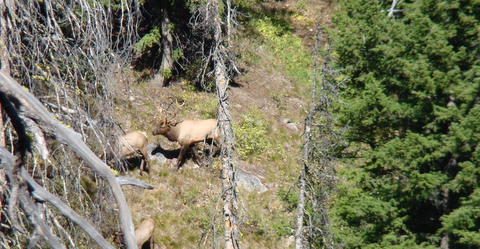 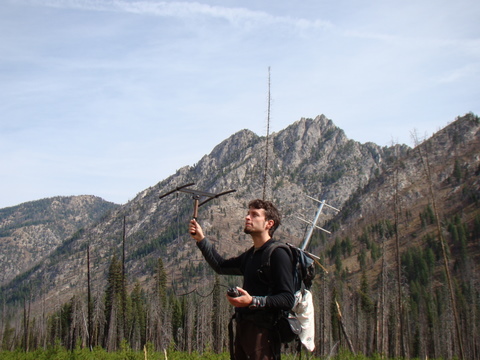 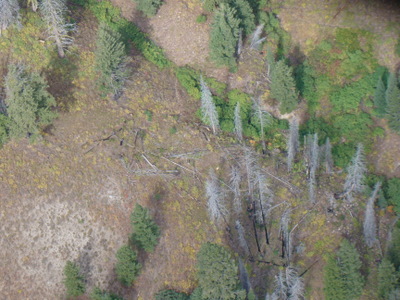
|
Forest Dynamics
- Understanding and predicting the local and global drivers of mountain tree lines. Ph.D. project Sébastien Renard

- Ecosystem change in Protected Areas within a Changing Climate Ouranos
 Project, in collaboration with Steve Cumming
Project, in collaboration with Steve Cumming  , Alison Munson, and a future PhD student. This project will involve spatio-temporal modeling of forest trees in Mauricie and Gaspésie.
, Alison Munson, and a future PhD student. This project will involve spatio-temporal modeling of forest trees in Mauricie and Gaspésie.
- Examining the impacts of climate change, microsite and seed dispersal on white spruce in Yukon, Canada. Jill Johnstone
 , Eric Pederson.
, Eric Pederson.
| Alpine Treeline |
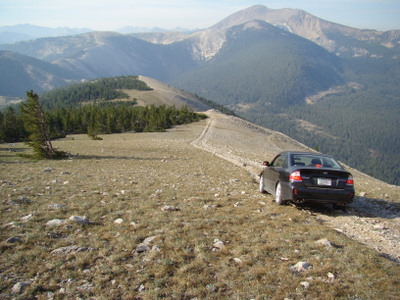 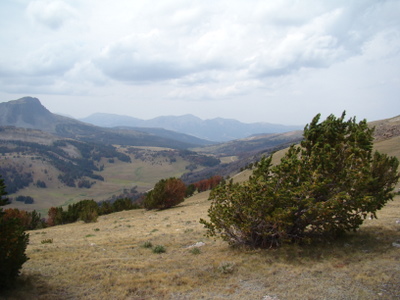 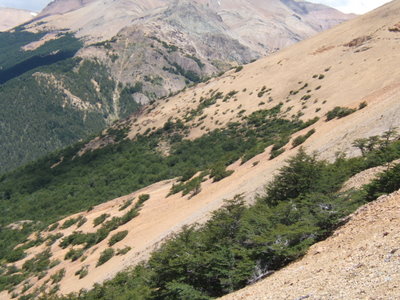
|
Whitebark Pine
- Predicting Whitebark Pine dynamics at the northern edges of its range, Coastal Mountians, BC, Canada. Ph.D. Alana Clason.
- Understanding physiological mechanisms and energy budgets of whitebark pine cone production in the Rocky Mountains, USA/Canada In collaboration with Elizabeth Crone
 and Anna Sala
and Anna Sala 
- Prediction of cone production in whitebark pine (Pinus albicaulis) in the Rocky Mountains, USA and Canada. In collaboration with Elizabeth Crone
 .
.
| Whitebark Pine |
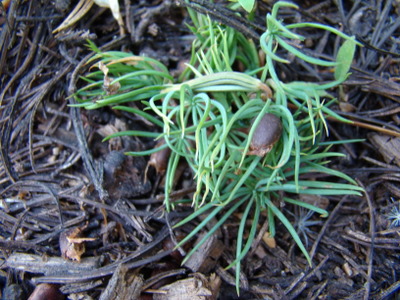 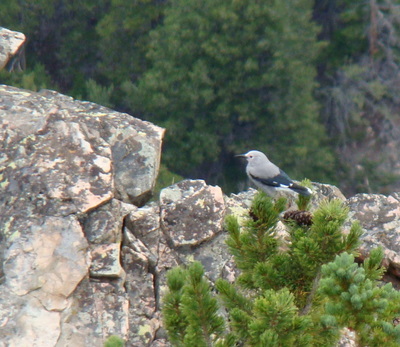 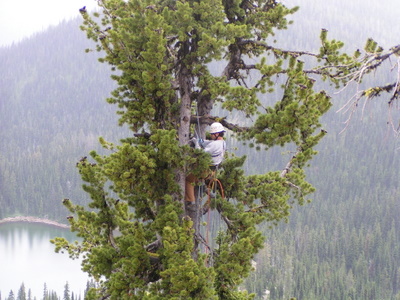
|
Climate Effects
- Wildlife Connectivity of Protected Areas within a Changing Climate Ouranos Project, in collaboration with Steve Cumming
 , Martin-Hugues St-Laurent
, Martin-Hugues St-Laurent  (UQAR). This project will involve spatio-temporal modeling of several species including Mountain Caribou (in Gaspésie) and black bears.
(UQAR). This project will involve spatio-temporal modeling of several species including Mountain Caribou (in Gaspésie) and black bears.
- Ecosystem change in Protected Areas within a Changing Climate Ouranos
 Project, in collaboration with Steve Cumming, Alison Munson, and a future PhD student. This project will involve spatio-temporal modeling of forest trees in Mauricie and Gaspésie.
Project, in collaboration with Steve Cumming, Alison Munson, and a future PhD student. This project will involve spatio-temporal modeling of forest trees in Mauricie and Gaspésie.
- Examining the impacts of climate change, microsite and seed dispersal on white spruce in Yukon, Canada. With Jill Johnstone
 , Eric Pederson.
, Eric Pederson.
- Understanding the local and global drivers of mountain tree lines. Ph.D. project Sébastien Renard

Quantitative Analysis
Hierarchical Bayes
- Detection and wildlife sampling. A collaborative project with Josh Nowak, Nicole Barker, and Christian Roy.
- Linking survival to resource selection functions. A Master's project by Émilie Allard on white-tailed deer in the Hautes Laurentides region of Québec.
- Predicting cone masting in Whitebark Pine. With Elizabeth Crone.
Spatial Simulation Models for Prediction
- Predicting Wolf Colonization across the northern Italian Alps. With Francesca Marucco.
- Conservation and restoration of Fender's blue butterfly, Oregon. With Elizabeth Crone and Cheryl Schultz.
Positive Interactions
Plant Facilitation
- Testing the Stress Gradient Hypothesis in Nothofagus (Chile) and White Spruce (Quebec) With Alex Fajardo
 , Sébastien Renard
, Sébastien Renard  .
.
- Understanding and predicting the local and global drivers of mountain tree lines. Ph.D. project Sébastien Renard

- Understanding the role of positive interactions in forest dynamics With Alex Fajardo
 and initiating a collaboration with Dr. Émilie Tarroux
and initiating a collaboration with Dr. Émilie Tarroux  .
.
Evolutionary consequences
- Quantifying the evolutionary impacts of positive interactions. With Alex Fajardo
 .
.
Methods
- Using space as a surrogate for understanding ecological mechanisms (McIntire & Fajardo, 2009). A project in collaboration with Alex Fajardo

- Wildlife population estimations using repeated surveys. Collaboration with Josh Nowak, Nicole Barker, Christian Roy.
Forest Dynamics
- Spatio-temporal dynamics of Nothofagus pumilio, Patagonia, Chile. Ongoing collaborations with Alex Fajardo
 .
.
- Regeneration above treeline in Chile: Physiological aspects. With Alex Fajardo
 and Frida Piper.
and Frida Piper.
Wildlife and Forestry
- Small mammal and snowshoe hare responses to 20 years of forest harvesting and natural disturbance M.S Pamela Garcia-Cournoyer
 .
.
Other
- Understanding Vegetation Dynamics in Small Stream Riparian Areas, Western Montana. M.Sc. Motoshi Honda, U. Montana.
- Forecasting Landscape Dynamics of Northern Goshawks in the Black Hills, South Dakota. M.Sc. Melanie Smith, U. Montana.
During my Ph.D.
I worked on issues related to Natural Disturbances in South-Central British Columbia, Canada:
- What are the boundaries of wildfires and mountain pine beetle outbreaks like? In other words, how wide are they, how complex are they, how heterogeneous are they?
- How important is this boundary complexity for a variety of the ecosystem? This includes, vegetation, coarse woody debris, and understory structure.
- What is the meaning of a disturbance in a disturbance-driven ecosystem? How do we define stability in ecosystems whose turnover is many centuries?
Prior to my Ph.D.
I worked on alpine ecosystems in Yukon, Canada, examining plant-herbivore dynamics of collared pikas, with David Hik.
I also examined the spatial patterns of disease infestation of wetland plants in northern fens, Quebec, Canada, with Marcia Waterway and Martin Lechowicz.
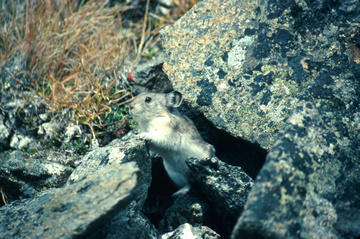  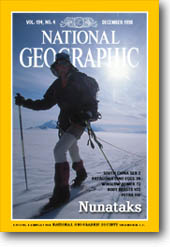
|
Former Students and Post Docs
Ghislain Rompré, Post doc, 2007-2009. Modeling the movement of butterflies. Currently, Ghislain is working as a Research Associate in Biology at Wilkes University ![]() , Pennsylvania.
, Pennsylvania.
Émilie Allard ![]() , M.Sc. 2007-2009. Understanding deer movement and habitat use in the Upper Laurentian region. Currently, Émilie is working as the Project Coodinator for the Innovation and Experimentation Service of the Coopérative forestière des Hautes-Laurentides.
, M.Sc. 2007-2009. Understanding deer movement and habitat use in the Upper Laurentian region. Currently, Émilie is working as the Project Coodinator for the Innovation and Experimentation Service of the Coopérative forestière des Hautes-Laurentides.
Francesca Marucco, Ph.D. 2004 - 2009. Modeling wolf recolonization in the European Alps. (University of Montana, Supervisor: Dan Pletscher ![]() ). Currently, Francesca is the scientific coordinator for the Wolf Project in the Western Italian Alps.
). Currently, Francesca is the scientific coordinator for the Wolf Project in the Western Italian Alps.
Motoshi Honda, M.Sc., 2005 - 2008, Spatial structure of riparian vegetation in mountain streams. (University of Montana). Currently, Motoshi is working for the Los Angeles water district.
Melanie Smith ![]() , M.Sc. Montana 2006, Modeling goshawks movement, reproduction and nest site selection in the Black Hills, South Dakota (University of Montana, Supervisor: Anna Klene). Currently, Biologist/GIS Analyst for the Alaska Audubon Society.
, M.Sc. Montana 2006, Modeling goshawks movement, reproduction and nest site selection in the Black Hills, South Dakota (University of Montana, Supervisor: Anna Klene). Currently, Biologist/GIS Analyst for the Alaska Audubon Society.
You can download all my bibliography in the BibTeX, BibTeX-CSV or EndNote format
PUBLICATIONS (Google Scholar  )
)
Books
None
Book chapters
- Ogle, K., Uriarte, J., Thompson, J., Johnstone, J., Jones, A., Lin, Y., McIntire, E.J.B., Zimmerman, J. (2006) Implications of vulnerability to hurricane damage for long-term survival of tropical tree species: a Bayesian hierarchical analysis. In Hierarchical modelling for the environmental sciences: Statistical methods and applications. (Clark, J.S. and Gelfand, A., Eds.) Oxford University Press, Oxford, UK
- Kimmins, J.P., McIntire, E.J.B. (2004) Ecosystem management and landscape ecology. In Forest ecology: A foundation for sustainable forest management and environmental ethics. (Kimmins, J.P., Eds.) Prentice Hall, NJ, USA, pages 533-542
Edited books, special journal editions and proceedings
None
Peer-reviewed articles
- Micheletti, T., Hache, S., Stralberg, D., Stewart, F.E.C., Chubaty, A.M., Barros, C., Bayne, E.M., Cumming, S.G., Docherty, T.D.S., Dookie, A. et al. (2023) Will this umbrella leak? A caribou umbrella index for boreal landbird conservation. Conservation Science and Practice, 5(4):e12908
- Barros, C., Luo, Y., Chubaty, A.M., Eddy, I.M.S., Micheletti, T., Boisvenue, C., Andison, D.W., Cumming, S.G., McIntire, E.J.B. (2023) Empowering ecological modellers with a PERFICT workflow: Seamlessly linking data, parameterisation, prediction, validation and visualisation. Methods in Ecology and Evolution, 14:173-188
- Stewart, F.E.C., Micheletti, T., Cumming, S.G., Barros, C., Chubaty, A.M., Dookie, A.L., Duclos, I., Eddy, I., Hache, S., Hodson, J. et al. (2023) Climate-informed forecasts reveal dramatic local habitat shifts and population uncertainty for northern boreal caribou. Ecological Applications, 33(3):e2816
- McIntire, E.J.B., Chubaty, A.M., Cumming, S.G., Andison, D., Barros, C., Boisvenue, C., Hache, S., Luo, Y., Micheletti, T., Stewart, F.E.C. (2022) PERFICT: A Re-imagined foundation for predictive ecology. Ecology Letters, 25(6):1345-1351
- Micheletti, T., Stewart, F.E.C., Cumming, S.G., Hache, S., Stralberg, D., Tremblay, J.A., Barros, C., Eddy, I.M.S., Chubaty, A.M., Leblond, M. et al. (2021) Assessing Pathways of Climate Change Effects in SpaDES: An Application to Boreal Landbirds of Northwest Territories Canada. Frontiers in Ecology and Evolution, 9
- Greuel, R.J., Degre-Timmons, G.E., Baltzer, J.L., Johnstone, J.F., McIntire, E.J.B., Day, N.J., Hart, S.J., McLoughlin, P.D., Schmiegelow, F.K.A., Turetsky, M.R. et al. (2021) Predicting patterns of terrestrial lichen biomass recovery following boreal wildfires. Ecosphere, 12(4)
- Stewart, F.E. C., Nowak, J.J., Micheletti, T., McIntire, E.J.B., Schmiegelow, F.K.A., Cumming, S.G. (2020) Boreal Caribou Can Coexist with Natural but Not Industrial Disturbances. The Journal of Wildlife Management, 84(8):1435-1444
- Bauduin, S., Cumming, S.G., St-Laurent, M.-H., McIntire, E.J.B. (2020) Integrating functional connectivity in designing networks of protected areas under climate change: A caribou case-study. PLOS ONE, 15(9):1-19
- Marchal, J., Cumming, S.G., McIntire, E.J.B. (2020) Turning Down the Heat: Vegetation Feedbacks Limit Fire Regime Responses to Global Warming. Ecosystems, 23(1):204-216
- Bauduin, S., McIntire, E.J.B., St-Laurent, M.-H., Cumming, S.G. (2018) Compensatory conservation measures for an endangered caribou population under climate change. Scientific Reports, 8
- Marchal, J., Cumming, S.G., McIntire, E.J.B. (2017) Land cover, more than monthly fire weather, drives fire-size distribution in Southern Quebec forests: Implications for fire risk management. PLOS ONE, 12(6)
- Marchal, J., Cumming, S.G., McIntire, E.J.B. (2017) Exploiting Poisson additivity to predict fire frequency from maps of fire weather and land cover in boreal forests of Québec, Canada. Ecography, 40(1):200-209
- Marchal, J., Cumming, S.G., McIntire, E.J.B. (2017) Correction: Land cover, more than monthly fire weather, drives fire-size distribution in Southern Québec forests: Implications for fire risk management (PLOS ONE (2017) 12:6 (e0179294) DOI: 10.1371/journal.pone.0179294). PLOS ONE, 12(9)
- Roy, C., McIntire, E.J.B., Cumming, S.G. (2016) Assessing the spatial variability of density dependence in waterfowl populations. Ecography, 39(10):942-953
- McIntire, E.J.B., Piper, F.I., Fajardo, A. (2016) Wind exposure and light exposure, more than elevation-related temperature, limit tree line seedling abundance on three continents. Journal of Ecology, 104(5):1379-1390
- Bauduin, S., McIntire, E.J.B., St-Laurent, M.-H., Cumming, S.G. (2016) Overcoming challenges of sparse telemetry data to estimate caribou movement. Ecological Modelling, 335:24-34
- Renard, S.M., McIntire, E.J.B., Fajardo, A. (2016) Winter conditions - not summer temperature - influence establishment of seedlings at white spruce alpine treeline in Eastern Quebec. Journal of Vegetation Science, 27(1):29-39
- Beguin, J., McIntire, E.J.B., Raulier, F. (2015) Salvage logging following fires can minimize boreal caribou habitat loss while maintaining forest quotas: An example of compensatory cumulative effects. Journal of Environmental Management, 163:234 - 245
- Roy, C., Cumming, S.G., McIntire, E.J.B. (2015) Spatial and temporal variation in harvest probabilities for American black duck. Ecology and Evolution, 5(10):1992-2004
- McIntire, E.J.B. (2014) Being a facilitator can be costly: teasing apart reciprocal effects. Commentary. New Phytologist, 202(1)
- McIntire, E.J.B., Fajardo, A. (2014) Facilitation as a ubiquitous driver of biodiversity. New Phytologist, 201:403-416
- Lorente, M., Parsons, W.F.J., McIntire, E.J.B., Munson, A.D. (2013) Wildfire and forest harvest disturbances in the boreal forest leave different long-lasting spatial signatures. Plant and Soil, 364(1-2):39-54
- Rapp, J.M., McIntire, E.J.B., Crone, E.E. (2013) Sex allocation, pollen limitation and masting in whitebark pine. Journal of Ecology, 101(5):1345-1352
- Severns, P.M., McIntire, E.J.B., Schultz, C.B. (2013) Evaluating functional connectivity with matrix behavior uncertainty for an endangered butterfly. Landscape Ecology, 28(3):559-569
- Brodie, J., Johnson, H., Mitchell, M., Zager, P., Proffitt, K., Hebblewhite, M., Kauffman, M., Johnson, B., Bissonette, J., Bishop, C. et al. (2013) Relative influence of human harvest, carnivores, and weather on adult female elk survival across western North America. Journal of Applied Ecology, 50(2):295–305
- McIntire, E.J.B., Rompre, G., Severns, P.M. (2013) Biased Correlated Random Walk and Foray Loop: which movement hypothesis drives a butterfly metapopulation? Oecologia
- Beguin, J., McIntire, E.J.B., Fortin, D., Cumming, S.G., Raulier, F., Racine, P., Dussault, C. (2013) Explaining geographic gradients in landscape selection by boreal caribou with implications under global changes. PLOS ONE
- Sala, A., Hopping, K., McIntire, E.J.B., Delzon, S., Crone, E.E. (2012) Masting in whitebark pine (Pinus albicaulis) depletes stored nutrients. New Phytologist, 196(1):189-199
- Fajardo, A., McIntire, E.J.B. (2012) Reversal of multicentury tree growth improvements and loss of synchrony at mountain tree lines point to changes in key drivers. Journal of Ecology, 100(3):782-794
- Larocque, G.R., Mailly, D., Yue, T.X., Anand, M., Peng, C., Kazanci, C., Etterson, M., Goethals, P., Jorgensen, S.E., Schramski, J.R. et al. (2011) Common challenges for ecological modelling: Synthesis of facilitated discussions held at the symposia organized for the 2009 conference of the International Society for Ecological Modelling in Quebec City, Canada, (October 6-9, 2009). Ecological Modelling, 222(14):2456-2468
- McIntire, E.J.B., Fajardo, A. (2011) Facilitation within species: a possible origin of group-selected superorganisms. American Naturalist, 178(1):88-97
- Crone, E.E., McIntire, E.J.B., Brodie, J. (2011) What defines mast seeding? Spatio-temporal patterns of cone production by whitebark pine. Journal of Ecology, 99(2):438-444
- Fajardo, A., McIntire, E.J.B. (2011) Under strong niche overlap conspecifics do not compete but help each other to survive: facilitation at the intraspecific level. Journal of Ecology, 99(2):642-650
- Johnstone, J.F., McIntire, E.J.B., Pedersen, E.J., King, G., Pisaric, M.J.F. (2010) A sensitive slope: estimating landscape patterns of forest resilience in a changing climate. Ecosphere, 1(6):art14
- Marucco, F., McIntire, E.J.B. (2010) Predicting spatio-temporal recolonization of large carnivore populations and livestock depredation risk: wolves in the Italian Alps. Journal of Applied Ecology, 47(4):789-798
- Desrochers, A., McIntire, E.J.B., Cumming, S.G., Nowak, J., Sharma, S. (2010) False negatives – a false problem in studies of habitat selection? Ideas in Ecology and Evolution, 3:20-25
- Fajardo, A., McIntire, E.J.B. (2010) Merged trees in second-growth, fire-origin forests in Patagonia, Chile: positive spatial association patterns and their ecological implications. American Journal of Botany, 97(9):1424-1430
- McIntire, E.J.B., Fajardo, A. (2009) Beyond description: the active and effective way to infer processes from spatial patterns. Ecology, 90(1):46-56
- MacKenzie, M.D., McIntire, E.J.B., Quideau, S.A., Graham, R.C. (2008) Charcoal Distribution Affects Carbon and Nitrogen Contents in Forest Soils of California. Soil Science Society of America Journal, 72(6):1774-1785
- Fajardo, A., McIntire, E.J.B. (2007) Distinguishing microsite and competition processes in tree growth dynamics: An a priori spatial modeling approach. American Naturalist, 169(5):647-661
- McIntire, E.J.B., Schultz, C.B., Crone, E.E. (2007) Designing a network for butterfly habitat restoration: Where individuals, populations and landscapes interact. Journal of Applied Ecology, 44(4):725-736
- McIntire, E.J.B., Fortin, M.-J. (2006) Structure and function of wildfire and mountain pine beetle forest boundaries. Ecography, 29(3):309-318
- McIntire, E.J.B., Duchesneau, R., Kimmins, J.P. (2005) Seed and bud legacies interact with varying fire regimes to drive long-term dynamics of boreal forest communities. Canadian Journal of Forest Research, 35(11):2765-2773
- McIntire, E.J.B., Hik, D.S. (2005) Influences of chronic and current season grazing by collared pikas on above-ground biomass and species richness in subarctic alpine meadows. Oecologia, 145(2):288-297
- McIntire, E.J.B. (2004) Understanding natural disturbance boundary formation using spatial data and path analysis. Ecology, 85(7):1933-1943
- McIntire, E.J.B., Waterway, M.J. (2002) Clonal structure and hybrid susceptibility to a smut pathogen in microscale hybrid zones of northern wetland Carex (Cyperaceae). American Journal of Botany, 89(4):642-654
- McIntire, E.J.B., Hik, D.S. (2002) Grazing history versus current grazing: Leaf demography and compensatory growth of three alpine plants in response to a native herbivore (Ochotona collaris). Journal of Ecology, 90(2):348-359
Articles published in proceedings
None
Scientific reports, manuals and others
- Micheletti, T., Stewart, F., McIntire, E.J.B., Eddy, I., Barros, C., Marchal, J., Stralberg, D., van Telgen, M., Raymundo, A., Chubaty, A.M. et al. (2019) Simulation effects of climate change on fire regime: implications for Boreal Caribou and landbird communities in the Northwest Territories. Technical report
Theses, dissertations and essays
- McIntire, E.J.B. (2003) Wildfire and mountain pine beetle boundary zones: spatial pattern, boundary creation and successional consequences. PhD thesis, University of British Columbia
- McIntire, E.J.B. (1999) The effects of collared pika grazing on alpine tundra vegetation in Southwestern Yukon, Canada. Master's thesis, University of Toronto
Supervised theses, dissertations and essays
- Marchal, J. (2017) Prévoir pour mieux s'adapter : sensibilité de l'activité des incendies de forêt aux changements climatiques et de couverture terrestre. PhD thesis, Université Laval
- Bauduin, S. (2016) Integrating functional connectivity and climate change in the design of protected area networks. PhD thesis, Université Laval
- Beguin, J. (2013) Analyse spatiale, sélection des paysages et stratégies de conservation en présence de régimes multiples de perturbation : le cas du caribou forestier en forêt boréale aménagée. PhD thesis, Université Laval
- Garcia Cournoyer, P. (2010) Évaluation de la naturalité de peuplements issus de scénarios sylvicoles en sapinière boréale. Master's thesis, Université Laval
- Allard, E. (2009) Utilisation hivernale des ravages du cerf de Virginie. Master's thesis, Université Laval
- Smith, M.A. (2007) Predicting Northern Goshawk Dynamics Using an Individual-based Spatial Model. Master's thesis, University of Montana
Non peer-reviewed articles
None







